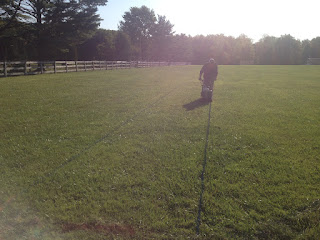Back to Avon South Middle School for renovating a mound on a budget. For this task, we had 50 bags of Dura Pitch Mound Clay and a new Jack Corbett 4-sided pitching rubber to install. A picture of the mound before we started this process is below
After tending to the edges (see renovating a home plate on a budget post for edging details) the task was to install the new pitching rubber 10 inches above home plate and making sure it was centered and square. The pitching rubber should be 60 ft 6 in from the apex of homeplate and each corner of the pitching rubber should be 59 ft 1 in from the corresponding front corners of the homeplate. Also, you will see a string line from the apex of homeplate to the middle of second base. The pitching rubber is center on the string line. To learn more about setting a pitching rubber click HERE.
After setting the pitchers rubber, the clay was added, once again with the concentration being on the slope of the mound, keeping in mind that we had limited clay due to the limited budget
Next, the new mound clay was tilled into the existing material
The mound was then sloped to spec - (i.e. - 6 inches in front of the mound was level with the pitchers rubber, and then falling one inch for every foot for the next six feet. To learn more about sloping a mound click HERE. A photo of the slope is below
After sloping the mound and building the table we boarded the rest of the mound in a similar fashion to the plate. Then we tire rolled the entire surface.
1 1/2 hrs later, we have a renovated mound on a budget!
The bottom line is, with the correct planning and the right materials, you can renovate a mound and plate on a very limited budget. Cost of the materials for both projects - $920.
Play on!
--Jamie
@JamieMehringer




















































